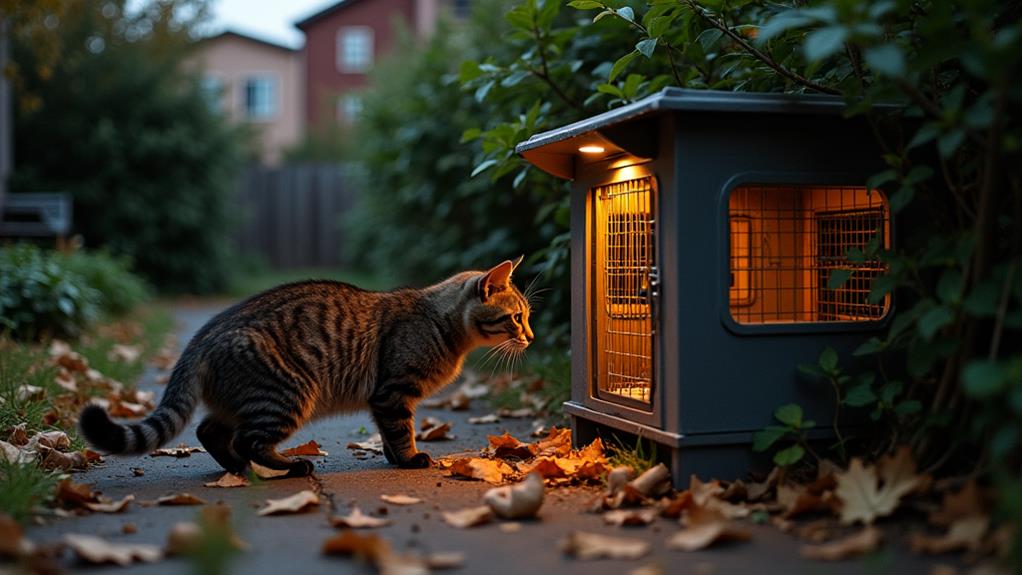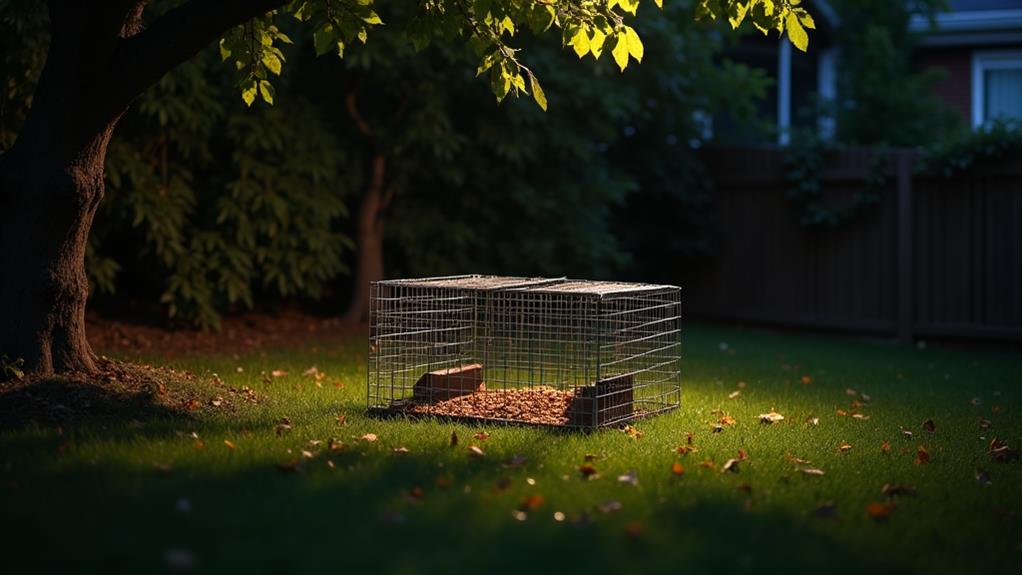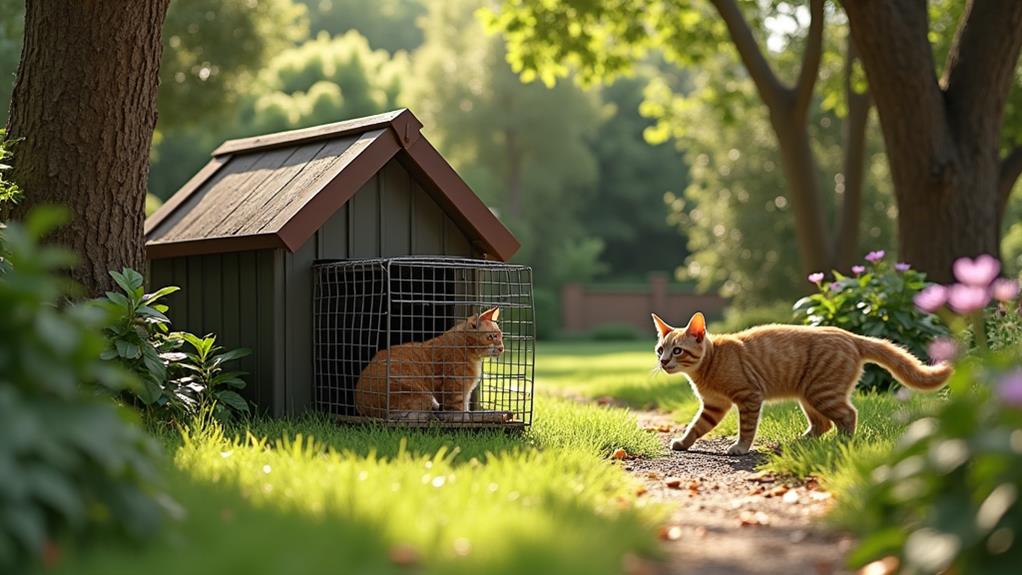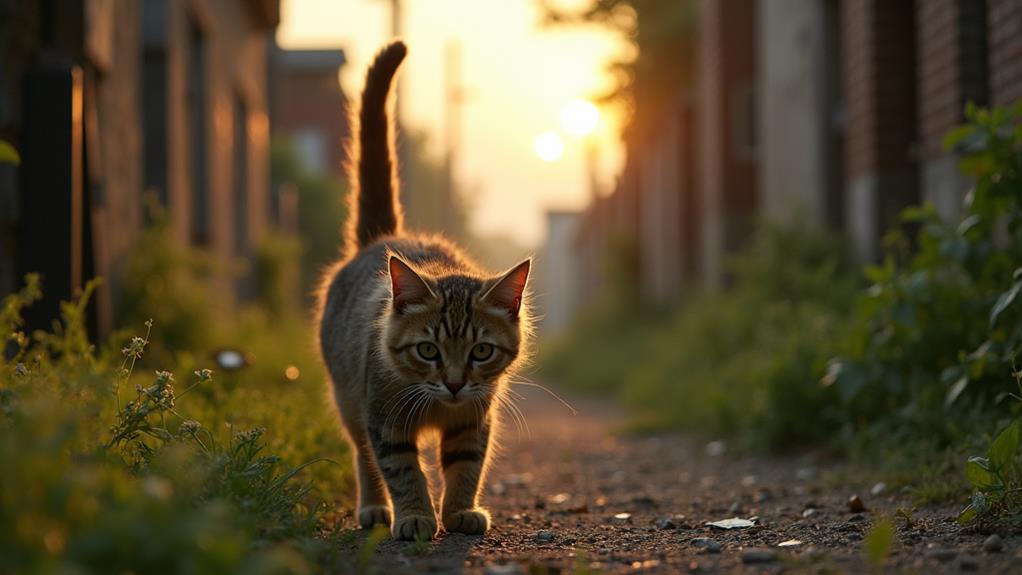How to Trap a Feral Cat in a Cage: Step-by-Step Instructions

To trap a feral cat, start by understanding their wary nature and active times, typically dusk or dawn. Gather a humane cat trap and bait like tuna. Establish a feeding routine at the same time and place daily, and withhold food 12 hours before trapping. Set the trap on a stable surface, lined with newspaper and covered with a blanket for comfort. Bait it effectively and monitor every 30 minutes. Once captured, approach calmly, cover the trap, and transport it safely. Confirm you're prepared for post-capture care and release. By following these steps, you'll achieve a successful capture.
Understanding Feral Cat Behavior
Understanding feral cat behavior is vital if you want to successfully trap one. Feral cats are naturally wary of humans, often avoiding direct contact and exhibiting flight responses when approached. This wariness is a significant behavior to understand when planning your trapping strategy. Unlike stray cats, feral cats haven't been socialized with humans, making them untrusting and often unadoptable. Recognizing these differences can help you tailor your approach to minimize stress for the cat and improve your chances of success.
Feral cats often form colonies where resources like food and shelter are plentiful. Within these groups, they display social behaviors, communicating through vocalizations, body language, and scent marking. Paying attention to these signals can provide insights into their mood and territorial boundaries, which can inform your trapping plan.
Timing is also important. Feral cats are most active at dusk and dawn, aligning your efforts with these peak activity times can boost your success. By understanding these natural behaviors, you can better predict their movements and choose the best time for trapping. Remember, patience and observation are your best tools in understanding feral cat behavior and successfully trapping them.
Gathering Trapping Supplies
Gathering the right trapping supplies is vital for a successful feral cat trapping mission. Start by obtaining a humane, medium-sized live trap specifically designed for cats. Confirm the trap has a smooth interior with no sharp edges, minimizing any risk of injury. This is pivotal for the safety and well-being of the cat.
Next, assemble a trapping kit. Include bait like canned cat food or tuna, which are effective at luring feral cats. A blanket or tarp is also significant, used for covering the trap once the cat is captured to keep it calm. Don't forget gloves for safe handling, protecting both you and the cat.
Prepare a safe, dry holding area for the cat post-capture. Equip it with clean bedding and food to support the cat's recovery. This step guarantees the cat is comfortable and well-cared-for after being trapped.
Consider having extra supplies on hand, such as a tarp for transporting the cat and labels for identifying individual traps if you're using multiple. Familiarize yourself with the trap's instructions and check that it's in good working condition before setting it up. This preparation will set the stage for a smooth trapping process.
Establishing a Feeding Routine

To successfully trap a feral cat, start by establishing a feeding routine that encourages regular visits. Set up a specific time and location to place food daily, making certain that the cat knows when and where to find a reliable meal. This consistency helps build trust and familiarity. Use enticing food options like canned cat food or tuna to attract the cats more effectively. The strong aroma of these foods is particularly appealing to feral cats and can make your feeding area more inviting.
As you establish this routine, spend time nearby while the cats eat. Avoid direct interaction, but allow them to see you. This helps them acclimate to your presence, slowly building trust over time. Remember, patience is key.
To increase the chances of trapping the cat, plan to withhold food for about 12 hours before you set the trap. This guarantees the cat is hungry and more motivated to enter the trap for food. Furthermore, communicate with neighbors to confirm they're not feeding the cats during this time. By controlling the food source, you'll improve the likelihood of successfully trapping the feral cat when the time comes.
Choosing the Right Trap
After establishing a feeding routine and gaining the cat's trust, focus on selecting the most appropriate trap for your needs. A humane live trap specifically designed for cats is vital. You'll want a medium-sized trap that's in good condition to guarantee effective use. Look for one with rolled internal edges to prevent injury, so the cat stays safe during the process.
The trap should also feature a hinged auxiliary door, which makes accessing the cat after capture easier and less stressful for both you and the feline. If you're attempting to trap a colony, consider using a trap with a divider. This will prevent direct contact between multiple cats, making the process smoother and more controlled.
Ease of use is important, so choose a trap that's easy to set up and has a sensitive trigger mechanism. This guarantees the cat is captured without delay as soon as it enters the trap. In addition, make sure the trap is lightweight and portable. This allows you to transport and place it in different locations where feral cats are active, increasing your chances of a successful capture.
Setting Up the Trap

Positioning the trap correctly is vital to successfully capturing a feral cat. Initially, choose a safe, medium-sized live trap designed specifically for cats. It should feature rolled internal edges to prevent injury. Find a known feeding area to place your trap. Ideally, it should be positioned 3-5 feet outside of the cat's shelter. Make certain the trap sits on a flat and stable surface to guarantee it functions effectively.
Line the bottom of the trap with newspaper for added comfort and cleanliness. This simple step can make a substantial difference in how inviting the trap seems to the cat. To reduce the trapped cat's stress, cover the trap with a blanket or cloth. This creates a dark, secure environment, making the cat feel safer once inside.
Monitoring the trap frequently, ideally every 30 minutes, is vital. This minimizes the time the cat spends inside, reducing stress. Remember, using strong-smelling food like tuna or sardines, placed strategically, is an essential part of the process. However, focus on your trap's positioning and setup initially, guaranteeing it's inviting and safe for the cat. This preparation greatly increases the likelihood of a successful capture.
Baiting the Trap Effectively
With your trap set up securely, it's time to focus on baiting it effectively to attract the feral cat. Start by choosing strong-smelling bait like tuna or sardines; their potent scent is irresistible to feral cats. Place the bait at the back of the trap, making certain the trap door remains open. This placement encourages the cat to fully enter the trap before the door closes.
Use only a small amount of bait to minimize attracting non-target animals while still enticing the feral cat. You want the cat to be motivated enough to enter the trap for food, so limiting external food sources is essential. Verify there are no alternative food options nearby that might distract the cat from your bait.
To further lure the cat, create a scent trail leading to the trap. Use the juice or oil from the bait to guide the cat's path directly to the trap's entrance. Place the bait on small paper plates at the back of the trap. This setup keeps the trap clean and guarantees the cat can access the bait easily without triggering the trap prematurely, increasing your chances of success.
Monitoring the Trap
Once your trap is set, it's vital to monitor it closely to guarantee the well-being of any captured cat. Begin by checking the trap every 30 minutes. This frequent monitoring helps minimize stress on the trapped cat and assures you can provide prompt care when needed. While monitoring the trap, keep a quiet distance to avoid startling the cat, which could compromise your trapping efforts.
Verify the trap is stable and on level ground to prevent it from tipping over. Regularly assess for signs of activity, such as movement or noise, indicating a successful capture. When you notice a cat has been trapped, approach the trap calmly and quietly. Immediately drape a blanket or cover over it. This step is vital as it helps calm the cat, reducing its anxiety and making the subsequent stages of handling less stressful for both you and the cat.
Don't forget to document the time of capture and any observed behaviors. This information is invaluable, as it informs future trapping strategies and helps improve your success rates. By diligently monitoring the trap, you guarantee the humane and effective capture of feral cats.
Transporting the Captured Cat
Transporting a captured feral cat requires careful planning to guarantee its safety and comfort. After trapping a cat, keep the trap covered with a blanket or tarp during transport. This minimizes stress and helps maintain a calm environment in your vehicle. Prepare the vehicle by laying a tarp or blanket on the floor to catch any accidents and make sure the cat has access to water, keeping it hydrated during the trip.
When transporting the captured cat, handle the trap carefully to prevent injury from any thrashing. Avoid sudden movements or loud noises, as these can startle the cat and increase its stress levels. A tranquil atmosphere is crucial for the cat's well-being.
Upon arrival at the veterinary clinic, inform the staff that the cat is feral. This guarantees they provide the proper handling and care needed. The Humane Society often recommends these steps to ensure the safe and humane treatment of feral cats.
Post-Capture Care and Release

After successfully capturing a feral cat, you'll need to focus on its post-capture care and release to guarantee its health and safety. Initially, keep the cat in the trap for recovery following anesthesia. This waiting period, lasting a few hours, allows the cat to regain full consciousness before you handle it further. Make certain the holding area is quiet, clean, and free of any hazards, creating a stress-free environment that aids in its recovery.
Next, follow the post-operative care instructions given by the veterinarian. Monitor the cat closely for any signs of distress or complications. These could include excessive bleeding, swelling, or lethargy. If you notice anything unusual, contact the vet immediately for advice. Generally, cats are ready to be released back into their original habitat 24 hours after surgery, provided they are alert and stable.
When you release the cat, verify it's returned to the exact location where it was trapped. This minimizes stress by allowing the cat to return to its familiar territory. Also, make certain it has access to food and water after release, as this supports its reintegration back to the wild.




